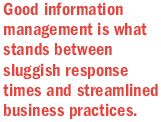Managing Information Overload
Companies know they need regulatory information management. What they don't always know is where to start and how to weave this vital capability across the enterprise.
Data is information waiting to happen, but today's global pharmaceutical companies are riddled with data—so much so that their numerous functions and disparate systems struggle to know what to do with all of it. Worse still, these data are usually disconnected, duplicated, and, all too often, inaccurate.
Data is generated by the day-to-day activities that take place in each department. Regulatory operations personnel, for example, produce documents, develop submissions, and file them in for approval. However, a submission begins long before the documents themselves are created. The process commences with the generation of concepts that get encapsulated into documents, which ultimately form the regulatory submission. Submissions become part of a portfolio across multiple nations, with concomitant licenses that must be managed. In most cases, data gathering is managed locally, with regulatory departments drawing on the minimum amount of information needed to adhere to requirements or track commitments.
What is often missing is the ability to aggregate information across the enterprise so that it can be used to conduct more predictive work, such as project planning across the portfolio, resource planning, and pre- and postmarketing activities. In so doing, companies can manage their activities more holistically. Other industries have been quicker to grasp the importance of information management.
Perhaps one of the best examples is the automobile industry. For example, when problems arise with a particular model, the manufacturer can respond quickly by linking information with warranty information. When a manufacturer spots a trend, like a faulty part, it can ensure that its dealers are ready with the new parts and also send out relevant recall letters, thereby helping to minimize any escalation in cost.
Cost of Failure
Pharmaceutical companies are aware of the data they generate and capture. According to a survey by the consulting group Ovum, the pharmaceutical industry is ahead of other industries when it comes to adopting enterprise applications, such as customer relationship management (CRM) and enterprise resource planning (ERP) solutions, but lags behind with business intelligence solutions such as regulatory tracking and management systems that can harness data productively. Poor information management can create a bottleneck for companies on multiple levels, as well as add unnecessary cost burdens. Take the cost of storage, for example; failing to manage data results in the retention of redundant information and records, which occupy storage space within a system. Then there's the time cost associated with chasing information needed to meet regulatory requirements or to make a business or strategic decision. One particular problem that company leaders have identified is the use of multiple terms or definitions to describe one thing, because it may mean that information about a product exists within several systems, with each system having its own definition. Consolidating this information can pose challenges. Information management aims to reduce the time it takes for people to locate relevant content and enable them to make confident business decisions based on informative data.
From a strategic point of view, good information management is what stands between sluggish response times and streamlined business practices. All of a company's information should be connected. Ideally, submissions flow into licensure, which then flows into the portfolio. Tracking resources via project planning, the authoring process, the submission process, the application process, and, ultimately, approval makes it possible to form a bigger picture of how resources are being managed and where they might best be directed. Companies can use this informational picture for resource prediction across multiple products and countries. For instance, good information management can concurrently track license renewals, products that are coming to the end of their patent life, new products entering the market, and the state of current R&D projects. This information can help answer questions such as:
» Is it in the company's interest to continue marketing a particular product?
» Should the company look for a partner?
» Are there opportunities for a product extension, and what would the market potential for additional indications be?
Good regulatory information management results in a detailed understanding of all the components pertinent to a particular product. If a problem arises somewhere along the line, it also enables the company to quickly determine what the problem is and decide on a resolution.
From Bottom to Top: The Info Stack
Successful information management requires a technology solution that encompasses all enterprise applications, including document management, ERP, and customer management. Ovum analyst Sarah Burnett describes the complete, multilayered enterprise package as the information management stack.

The information stack begins at the infrastructure level, which comprises both internal applications, such as file systems, databases, and archiving; and external sources of data, which may encompass cloud deployments such as software services, RSS feeds, and web-generated information.
Next comes data management, life cycle management, the retirement of old data that is no longer required, archiving, and records management. Often, companies have data or reports that, while not active, need to be accessible in the near term. Even though some solutions allow for this type of storage, it's important that companies learn how to classify information to simplify the task of finding it. There's a need to standardize the way information is classified, as the use of different terms negates the value of data storage. Another crucial aspect is metadata management. What that means is that more time needs to be spent resolving issues around data definitions and improving data quality, because having good and consistent data from the outset will allow companies to produce better quality reports and analysis.
The third layer in the information management technology stack comprises data extraction and integration. First, there's data warehousing or data consolidation, which deals with longer-term data cycles. This system is most appropriate when there are definitional discrepancies or when a lot of data cleansing is required. Data warehousing or data consolidation is valuable insofar as it lets personnel conduct multidimensional analyses. If, for example, a number of issues have arisen during drug development, business leaders can use the data to analyze the value and cost of the project.
Another technology that fits into the extraction and integration layer is data federation, or data virtualization, whereby a department or business leader might grab snippets of information from different systems for quick access and analysis. This technology is most applicable for small quantities of data that don't require substantial transformation or cleansing. According to Burnett, data virtualization enables users to quickly access data that is pertinent to their particular requirements. Master data management, which gives users a single view of an important part of the business, such as a product or a customer, also fits into this layer. One example might be filling in missing pieces of data in a record or removing errors from a record. The final part of the extraction/integration stack is service-oriented architecture or data services. This is another way of breaking data into components that can be reused at various points throughout the organization.
Information services is second from the top of the stack. For most users, this level is where the more familiar tools and applications such as search, retrieval, audit, and forecast are found.
At the top of the stack is delivery, which focuses on making information easier for the user to digest and understand. Delivery allows information to be synthesized for a particular user, such as financial, project management and development, or scientific research.
Conclusion
Regulatory information management involves more than tracking submissions. The processes and technologies used to enable successful regulatory information management help companies consolidate disparate systems and produce meaningful, holistic information that leads to better decision-making. Only by having clean, consistent, and reliable data is it possible to build a broad picture of how an organization's resources are currently being used and how they can be maximized in the future.

Addressing Disparities in Psoriasis Trials: Takeda's Strategies for Inclusivity in Clinical Research
April 14th 2025LaShell Robinson, Head of Global Feasibility and Trial Equity at Takeda, speaks about the company's strategies to engage patients in underrepresented populations in its phase III psoriasis trials.
Beyond the Prescription: Pharma's Role in Digital Health Conversations
April 1st 2025Join us for an insightful conversation with Jennifer Harakal, Head of Regulatory Affairs at Canopy Life Sciences, as we unpack the evolving intersection of social media and healthcare decisions. Discover how pharmaceutical companies can navigate regulatory challenges while meaningfully engaging with consumers in digital spaces. Jennifer shares expert strategies for responsible marketing, working with influencers, and creating educational content that bridges the gap between patients and healthcare providers. A must-listen for pharma marketers looking to build trust and compliance in today's social media landscape.